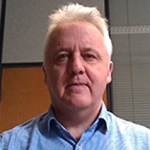Happy Cows for a Cooler Planet
Sophie Strauss, Science and Policy Intern
When I think of greenhouse gas (GHG) emissions, I think of oil and gas companies, lobbyists, smog, and factories. I sometimes think of gas-passing cows, obliviously heating the Earth with their methane-abundant farts. However, I didn’t expect that the happiness of said cows would play into the equation. According to Craig Michie, professor of electrical and electronic engineering at the University of Strathclyde in Scotland, keeping cows content can save our planet (or at least keep it healthy).

Craig Michie
Methane is the second-most abundant greenhouse gas generated by human activities. Typically we look to the oil and gas sector to reduce their methane emissions: a recent report from Optica and the American Physical Society describes ways the industry could better monitor their methane emissions and reduce them. But oil and gas only contribute to about 30 percent of methane emissions, with agriculture and waste constituting most of the remaining sources of emissions. Fortunately, experts like Michie are looking for innovative ways to curb agriculture’s methane production.
This topic was at the center of Michie's webinar, "Sensing in Dairy Farming and its Role in Green House Gas Mitigation,” which he presented on 23 May. In his talk, Michie discusses the use of low-cost sensors to track the movements of individual cows, determine when they are ready for insemination (known as being “in heat”), increase milk production, increase farm efficiency and thereby lower methane emission from dairy farms. According to Michie, one of the main causes of emission-causing inefficiency is stress caused by high temperatures known as heat stress: When a cow is stressed, it produces less milk than when it is content. The less milk a cow produces, the more cows a dairy farm must have to maintain its output, and the more methane it emits per kilogram of milk produced.
Similar to people, cows are becoming increasingly difficult to please. With consolidation across the industry, dairy farms are decreasing in number and increasing in size. These new megafarms are home to so many cows that farmers struggle to monitor each cow’s condition. Therefore, a farmer may miss when a cow is in heat, under stress or ill. Missing a heat cycle, in particular, loses the farmer revenue and contributes to gas inefficiency. In fact, a farmer loses about GBP£200 per missed cycle. The prospect of reducing these losses, in part, caused dairy farmers to respond openly and positively when Prof. Michie and his team proposed to set up sensors to track the cows’ actions. These small, cheap and astonishingly power-efficient motion sensors and tiny radio transmitters send data back to the farmer. The systems are so efficient they will run for a decade without a battery change.
Within a few years of installing the sensors, the area’s Calving Index—or the average number of days between pregnancies for a particular herd—decreased dramatically, and with it, the losses of revenue. The return investment was up to GBP£112,000 for 500 cows—the farmers were able to pay them off within six months.
In addition to tracking cow pregnancies, the sensors measured the condition of the cows. Michie’s team found that the herd was in heat distress for 8-10 hours per day. With this knowledge, the dairy farmers could add sprinklers or other mitigating factors in order to optimize cow contentment and well-being, a cause we can all support.
How can happy cows reduce GHG emissions? According to Michie, “[U]sing whatever you can … to optimize both the herd fertility, and hence the yield, and also the welfare gives you an opportunity to minimize the contribution that [dairy production] has given to the greenhouse gas emissions as a fraction of the product that you’re producing.” In other words, optimizing herd fertility and welfare minimizes methane emissions. While feed additives are another potential method of reducing methane emissions by significant percentages (about 30% for dairy cows and up to 90% for beef cows), some additives come with complications, such as iodine toxicity caused b seaweed ‘asparagopsis’ additives.
The real question, in the long term, is whether these improvements last. According to Michie, we need a method to determine the answer, and point sensors are the most cost-effective, and therefore accessible, one we have. The next frontier in GHG measurement is now being explored through a large sensor system being deployed in and around Glasgow by Michie, a team of scientists and engineers at the University of Strathclyde, and members of the Global Environmental Measurement and Monitoring (GEMM) Initiative.
GEMM, a collaboration of Optica and the American Geophysical Union (AGU), brings together researchers from around the world to collaborate on environmental measurements. Ron Cohen, a GEMM participant from the University of California Berkeley, has developed a sensor platform called the Berkeley Environmental Air-quality & CO2 Network (BEACO2N) based on optical sensor technology. Researchers at Strathclyde are deploying BEACO2N platforms around Glasgow. The data from large numbers of simple sensors, much like the cow sensors, will provide researchers with the raw material needed to understand GHG emissions, trace those emissions back to their sources and inform data-driven policy making.
With improved sensing and modeling, we can determine the main sources of methane, and with inexpensive sensor technologies, we can expand their applications to the beef sector as well as pig, poultry and other types of farming. Michie has convinced me that sensing on farms has the proven potential to mitigate the effects of climate change (not to mention benefiting the dairy sector). Holy cow!
Michie's webinar may be seen here. Another great webinar, Optical Sensing of the Atmosphere – From the Laboratory to Global Monitoring from 09 May is also available online. For even more environmental imaging and sensing content, join Optica from 11 to 15 July at the hybrid co-located Optical Sensors and Sensing Congress and the Imaging and Applied Optics Congress. The in-person portion will be held in Vancouver, Canada. We hope to see you there!
